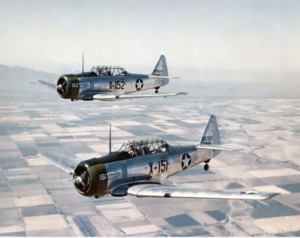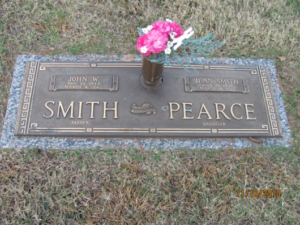Scroll of Honor – John William “Bill” Smith
The Price of Proficiency
To dive bomb the enemy with any hope of achieving a hit and inflicting damage,  the pilot of the aircraft had to be proficient in aiming his plane at the target. The only way to achieve the level of skill demanded in combat was to train.
the pilot of the aircraft had to be proficient in aiming his plane at the target. The only way to achieve the level of skill demanded in combat was to train.
Nineteen thirty-two was a watershed year for the United States. A new president was elected, one whom the people believed offered the best chance at defeating the Great Depression and putting the country on the road to recovery. It was also the year that John William “Bill” Smith of Greenville enrolled at Clemson College as a member of the Class of 1936.
During four years at Clemson, Smith, a chemistry major seemed to make little impact on the campus. He participated in ROTC, but finished his senior year as a private. Nonetheless, when America found itself at war in December 1941, Smith was already on active duty.
Following graduation, Smith had worked with the DuPont Corporation in Tennessee. Volunteering for the Army Air Force, Smith trained at Randolph Field and Kelly Field, both near San Antonio, Texas before being assigned to Eglin Field near Valparaiso, Florida.
On March 4, 1942, with the United States reeling in the Pacific and not yet engaged  in the European Theater, Smith took part in a training flight as a passenger in an AT-6A Texan. The AT-6 was an advanced trainer used by the Army Air Force, the Navy (as the SNJ) and the British (as the Harvard). Smith would be flying in aircraft #41-528 on a simulated dive bombing mission just north of Eglin’s auxiliary field No. 4. The pilot of the aircraft was Second Lieutenant Richard Baldsiefen.
in the European Theater, Smith took part in a training flight as a passenger in an AT-6A Texan. The AT-6 was an advanced trainer used by the Army Air Force, the Navy (as the SNJ) and the British (as the Harvard). Smith would be flying in aircraft #41-528 on a simulated dive bombing mission just north of Eglin’s auxiliary field No. 4. The pilot of the aircraft was Second Lieutenant Richard Baldsiefen.
At approximately 1346 Central War Time, Baldsiefen, flying in a formation with three other aircraft, nosed his plane over into its dive from an altitude of 8,000 feet. Immediately, the aircraft began to accelerate as it streaked downward at a steep angle. At approximately 3,000 feet, the aileron, the control surface on the trailing edge of the wing which controls the lateral roll of the aircraft, tore loose from the left wing. Then, the outer wing ripped away making it impossible for Baldsiefen to control the aircraft. The plane began to spin, preventing either Baldsiefen or Smith from bailing out. The resulting crash killed both men.
Army investigators determined that “error of judgment” led to the crash. They estimated that the aircraft speed reached 250 miles per hour, well above the AT-6’s maximum safe speed of 208.
First Lieutenant Bill Smith’s remains were returned to Greenville where he  was buried at Woodlawn Cemetery. He was survived by his wife Margaret and daughter Jean.
was buried at Woodlawn Cemetery. He was survived by his wife Margaret and daughter Jean.
For more information about First Lieutenant John William Smith see:
https://soh.alumni.clemson.edu/scroll/john-william-smith/
For additional information about Clemson University’s Scroll of Honor visit:
https://soh.alumni.clemson.edu/
